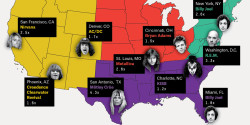Just what is Classic Rock? It’s a question that has vexed many a radio listener tuned in to a set that includes Billy Joel, Led Zeppelin, the Clash and Motley Crue, artists that likely wouldn’t have been played together on any other format. What’s the connecting feature? What’s in the center of that Venn diagram? Is it age of the song or artist, or some super-secret formula locked in a vault next to the Colonel’s seven herbs and spices and the recipe for New Coke?
FiveThirtyEight’s Walt Hickey investigated this quandary using the site’s signature statistical methodology. Aggregating the playlists of 25 classic rock stations Hickey crunched through a sample of, “2,230 unique songs by 475 unique artists, with a total record of 37,665 coded song plays across the stations.”
What he learned is that there is no one formula for Classic Rock, and that location is one important variable:
What plays in New York — a disproportionate amount of Billy Joel, for example — won’t necessarily fly in San Antonio, which prefers Mötley Crüe. Classic rock is heavily influenced by region, and in ways that are unexpected. For example, Los Angeles is playing Pearl Jam, a band most popular in the 1990s, five times more frequently than the rest of the country. Boston is playing the ’70s-era Allman Brothers six times more frequently.
Songs from 1973 to 1982 account for the majority of plays, but release date is not the only quality that matters. So does a band’s overall longevity and its sound. Major market stations also rely heavily on research, polling radio listeners about what songs they consider to be Classic Rock, which potentially sounds like a never-ending feedback loop.
According to the Classic Rock brand manager for Clear Channel, Eric Wellman, immigration and migration around the country have an effect, too. He said, “The common conventional wisdom is that Hispanics who listen to English-language rock like a significantly harder brand of English-language rock. In markets where that is an influence, you’ll see that.”
See FiveThirtyEight’s infographic for more regional insights.
There is, however, one thing that doesn’t factor in at all: DJs themselves. Wellman said, “I know there are some stations and some companies where if you change a song it’s a fireable offense.” Uh, one of those companies wouldn’t be Clear Channel, would it? Oh, right, computer automation systems aren’t yet sentient enough to toss an obscure Blue Cheer b-side into rotation. No risk there.
To cynical radio veterans like myself there’s no surprises here, especially the part about DJs not picking songs. That hasn’t happened in most commercial radio for decades, if there’s even a real, actual DJ anywhere near the air studio.
However I must admit that I mistakenly surmised there was some kind of 10-year rule at work. That assumption was primarily based upon the times I first heard relatively newer bands like Nirvana or REM crop up on a Classic Rock station. While I have a hard time imagining a band that’s less than a decade old being spun on Classic Rock, it’s clear that the truth is more complex, and disappointing, than that.



